Anatomy of flowering plant 1000+ MCQ with answer for CEED
Thursday 9th of March 2023

Sharing is caring
1. Which one of the following option shows the correct labelling of the parts marked as A, B, C and D in the given figure of a typical dicot root?
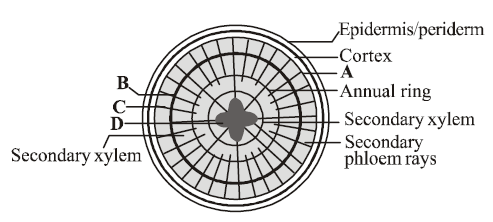
A. A Primary phloem, B Vascular cambium, C Secondary phloem, D Primary xylem
B. A Secondary phloem, B Vascular cambium, C Primary phloem, D Primary xylem
C. A Primary phloem, B Primary xylem, C Secondary phloem, D Vascular cambium
D. A Secondary phloem, B Primary xylem, C Primary phloem, D Vascular cambium
Answer : A

A. A Primary phloem, B Vascular cambium, C Secondary phloem, D Primary xylem
B. A Secondary phloem, B Vascular cambium, C Primary phloem, D Primary xylem
C. A Primary phloem, B Primary xylem, C Secondary phloem, D Vascular cambium
D. A Secondary phloem, B Primary xylem, C Primary phloem, D Vascular cambium
Answer : A
2. Which one of the following have vessels as their characteristic feature?
A. Angiosperms
B. Gymnosperms
C. Pteridophytes
D. Bryophytes
Answer : A
A. Angiosperms
B. Gymnosperms
C. Pteridophytes
D. Bryophytes
Answer : A
3. In land plants, the guard cells differ from other epidermal cells in having
A. cytoskeleton.
B. mitochondria.
C. endoplasmic reticulum.
D. chloroplasts.
Answer : D
A. cytoskeleton.
B. mitochondria.
C. endoplasmic reticulum.
D. chloroplasts.
Answer : D
4. Match the terms given in column I with their features given in column II and choose the correct option.
A. A - (i), B - (ii), C - (iii), D - (iv), E - (v)
B. A - (iii), B - (v), C - (ii), D - (iv), E - (i)
C. A - (iii), B - (i), C - (v), D - (ii), E - (iv)
D. A - (v), B - (iv), C - (iii), D - (i), E - (ii)
Answer : B
| Column-I | Column-II |
|---|---|
| (Terms) | (Features) |
| A. Fibres | (i) Cells are living and thin walled with cellulosic cell wall, store food materials in the form of starch or fat |
| B. Sclereids | (ii) Main water conductive cells of the pteridophytes and the gymnosperms |
| C. Tracheids | (iii) Thick walled, elongated and pointed cells, generally occurring in groups |
| D. Vessels | (iv) Long cylindrical tube like structure and cells are devoid of protoplasm. Characteristic feature of angiosperms |
| E. Xylem parenchyma | (v) Reduced form of sclerenchyma cells with highly thickened lignified cellular walls that form small bundles of durable layers of tissue in most plants. |
A. A - (i), B - (ii), C - (iii), D - (iv), E - (v)
B. A - (iii), B - (v), C - (ii), D - (iv), E - (i)
C. A - (iii), B - (i), C - (v), D - (ii), E - (iv)
D. A - (v), B - (iv), C - (iii), D - (i), E - (ii)
Answer : B
5. Which of the following statement(s) is/are correct ?
A. (i) and (iv) only
B. (ii) and (v) only
C. (iii) and (iv) only
D. (ii), (iii) and (v) only
Answer : D
- Uneven thickening of cell wall is characteristic of sclerenchyma.
- Periblem forms cortex of the stem and the root.
- Tracheids are the chief water transporting elements in gymnosperms.
- Companion cell is devoid of nucleus at maturity.
- The commercial cork is obtained from Quercus suber.
A. (i) and (iv) only
B. (ii) and (v) only
C. (iii) and (iv) only
D. (ii), (iii) and (v) only
Answer : D
6. T.S. of dicot leaf passing through the midrib is given below. Certain parts have been marked by alphabets (A to H). Choose the option showing their correct labelling.

A. A Epidermis, B Spongy mesophyll, C Palisade mesophyll, D Stomata, E Guard cells, F Phloem, G Metaxylem, H Protoxylem
B. A Epidermis, B Palisade mesophyll, C Spongy mesophyll, D Sub-stomatal cavity, E Stoma, F Phloem, G Xylem, H Bundle sheath
C. A Epidermis, B Palisade mesophyll, C Spongy mesophyll, D Stomata, E Guard cells, F Epidermis, G Xylem, H Phloem
D. A Epidermis, C Palisade mesophyll, C Spongy mesophyll, D Stomata, E Guard cells, F Phloem, G Metaxylem, H Protoxylem
Answer : B

A. A Epidermis, B Spongy mesophyll, C Palisade mesophyll, D Stomata, E Guard cells, F Phloem, G Metaxylem, H Protoxylem
B. A Epidermis, B Palisade mesophyll, C Spongy mesophyll, D Sub-stomatal cavity, E Stoma, F Phloem, G Xylem, H Bundle sheath
C. A Epidermis, B Palisade mesophyll, C Spongy mesophyll, D Stomata, E Guard cells, F Epidermis, G Xylem, H Phloem
D. A Epidermis, C Palisade mesophyll, C Spongy mesophyll, D Stomata, E Guard cells, F Phloem, G Metaxylem, H Protoxylem
Answer : B
7. Main function of lenticel is
A. transpiration
B. guttation
C. gaseous exchange
D. both (a) & (c)
Answer : A
A. transpiration
B. guttation
C. gaseous exchange
D. both (a) & (c)
Answer : A
8. Bast fibres are made up of _____________cells.
A. sclerenchymatous
B. chlorenchymatous
C. parenchymatous
D. aerenchymatous
Answer : A
A. sclerenchymatous
B. chlorenchymatous
C. parenchymatous
D. aerenchymatous
Answer : A
9. Which of following helps bamboo and grasses to elongate ?
A. Apical meristems
B. Lateral meristems
C. Secondary meristems
D. Intercalary meristems
Answer : D
A. Apical meristems
B. Lateral meristems
C. Secondary meristems
D. Intercalary meristems
Answer : D
10. Some vascular bundles are described as open because these
A. are surrounded by pericycle but not endodermis.
B. are capable of producing secondary xylem and phloem.
C. possess conjunctive tissue between xylem and phloem.
D. are not surrounded by pericycle.
Answer : B
A. are surrounded by pericycle but not endodermis.
B. are capable of producing secondary xylem and phloem.
C. possess conjunctive tissue between xylem and phloem.
D. are not surrounded by pericycle.
Answer : B
11. Read the following statements and answer the question.
Which type of wood is described by the above statements?
A. Sap wood
B. Heart wood
C. Spring wood
D. Autumn wood
Answer : C
- Cambium is very active and produces a large number of xylary elements having vessels with wider cavities.
- It is also called early wood.
- It is lighter in colour and has lower density.
Which type of wood is described by the above statements?
A. Sap wood
B. Heart wood
C. Spring wood
D. Autumn wood
Answer : C
12. Cells of permanent tissues are specialized
A. functionally.
B. only structurally.
C. both structurally and functionally.
D. for mitosis.
Answer : C
A. functionally.
B. only structurally.
C. both structurally and functionally.
D. for mitosis.
Answer : C
13. In the given figure of phloem tissue, identify the marked part (A, B and C) which help in maintaining the pressure gradient
in the sieve tubes.
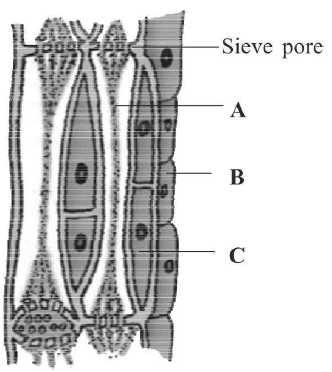
A. A
B. B
C. C
D. None of the above
Answer : C
in the sieve tubes.

A. A
B. B
C. C
D. None of the above
Answer : C
14. Choose the correct labelling of (A J) in the given figure of T.S. of monocot root.

A. A Root hair, B Epiblema, C Cortex, D Endodermis, E Passage cell, F Pericycle, G Pith, H Phloem, I Metaxylem.
B. A Root hair, B Epiblema, C Cortex, D Endodermis, E Passage cell, F Pith, G Pericycle, H Metaxylem, I Phloem.
C. A Root hair B Epiblema, C Cortex, D Endodermis, E Pericycle, F Phloem, G Protoxylem, I Metaxylem
D. A Root hair, B Cortex, C Epiblema, D Pericycle, E Endodermis, F Pith, G Phloem, H Protoxylem, I Metaxylem
Answer : C

A. A Root hair, B Epiblema, C Cortex, D Endodermis, E Passage cell, F Pericycle, G Pith, H Phloem, I Metaxylem.
B. A Root hair, B Epiblema, C Cortex, D Endodermis, E Passage cell, F Pith, G Pericycle, H Metaxylem, I Phloem.
C. A Root hair B Epiblema, C Cortex, D Endodermis, E Pericycle, F Phloem, G Protoxylem, I Metaxylem
D. A Root hair, B Cortex, C Epiblema, D Pericycle, E Endodermis, F Pith, G Phloem, H Protoxylem, I Metaxylem
Answer : C
15. Identify A, B and C in the given figure of shoot apical meristem
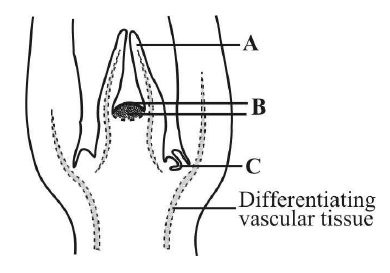
A. A Leaf primordium, B Shoot apical meristem, C Axillary bud
B. A Leaf primordium, B Shoot apical meristem, C Apical bud
C. A Root hair primordium, B Root apical meristem, C Axillary bud
D. A Root hair primordium, B Root apical meristem, C Terminal bud
Answer : A

A. A Leaf primordium, B Shoot apical meristem, C Axillary bud
B. A Leaf primordium, B Shoot apical meristem, C Apical bud
C. A Root hair primordium, B Root apical meristem, C Axillary bud
D. A Root hair primordium, B Root apical meristem, C Terminal bud
Answer : A
16. Which of the following pair of match is not correct?
A. Pith - Large and well developed in monocotyledonous root.
B. Root hairs - Helps in preventing water loss due to transpiration
C. Sieve tube elements - Its functions are controlled by the nucleus of companion cells.
D. Stomatal apparatus - Consists of stomatal aperture, guard cells and surrounding subsidiary cells
Answer : A
A. Pith - Large and well developed in monocotyledonous root.
B. Root hairs - Helps in preventing water loss due to transpiration
C. Sieve tube elements - Its functions are controlled by the nucleus of companion cells.
D. Stomatal apparatus - Consists of stomatal aperture, guard cells and surrounding subsidiary cells
Answer : A
17. The __________ occurs in layers below the epidermis in dicotyledonous plants.
A. parenchyma
B. sclerenchyma
C. collenchyma
D. aerenchyma
Answer : C
A. parenchyma
B. sclerenchyma
C. collenchyma
D. aerenchyma
Answer : C
18. Apical and intercalary meristems are primary meristems because
A. they occur in the mature region of roots and shoots of many plants.
B. they made up of different kinds of tissues.
C. they involved in secondary growth.
D. they appear early in life of a plant and contribute to the formation of the primary plant body.
Answer : D
A. they occur in the mature region of roots and shoots of many plants.
B. they made up of different kinds of tissues.
C. they involved in secondary growth.
D. they appear early in life of a plant and contribute to the formation of the primary plant body.
Answer : D
19. The given figure shows the T.S of dicot root. Some parts are marked as A, B, C, D, E, & F. Choose the option which shows the correct labelling of marked part.

A. A Epiblema, B Root hair, C Cortex, D Endodermis, E Pith, F Pericycle
B. A Cortex, B Pith, C Epiblema, D Endodermis, E Root hair, F Pericycle
C. A Epiblema, B Endodermis, C Cortex, D Root hair, E Pith, F Pericycle
D. A Cortex, B Epiblema, C Pith, D Endodermis, E Root hair, F Pericycle
Answer : D

A. A Epiblema, B Root hair, C Cortex, D Endodermis, E Pith, F Pericycle
B. A Cortex, B Pith, C Epiblema, D Endodermis, E Root hair, F Pericycle
C. A Epiblema, B Endodermis, C Cortex, D Root hair, E Pith, F Pericycle
D. A Cortex, B Epiblema, C Pith, D Endodermis, E Root hair, F Pericycle
Answer : D
20. Which of the following is responsible for the formation of an embryonic shoot called axillary bud?
A. Lateral meristem
B. Apical meristem
C. Intercalary meristem
D. Both
Answer : C
A. Lateral meristem
B. Apical meristem
C. Intercalary meristem
D. Both
Answer : C
21. Match the followings and choose the correct option
A. A III, B IV, C I, D II
B. A I, B II, C III, D IV
C. A III, B II, C IV, D I
D. A III, B II, C I, D IV
Answer : A
| Column-I | Column-II |
|---|---|
| A. Cuticle | I. Guard cells |
| B. Bulliform cells | II. Outer layer |
| C. Stomata | III. Waxy layer |
| D. Epidermis | IV. Empty colourless cell |
A. A III, B IV, C I, D II
B. A I, B II, C III, D IV
C. A III, B II, C IV, D I
D. A III, B II, C I, D IV
Answer : A
22. Cambium is considered as a lateral meristem because
A. it gives rise to lateral branches.
B. it causes increase in girth.
C. it increases height and diameter of a plant.
D. it adds bulk to a plant.
Answer : B
A. it gives rise to lateral branches.
B. it causes increase in girth.
C. it increases height and diameter of a plant.
D. it adds bulk to a plant.
Answer : B
23. Which meristem helps in increasing girth?
A. Lateral meristem
B. Intercalary meristem
C. Primary meristem
D. Apical meristem
Answer : A
A. Lateral meristem
B. Intercalary meristem
C. Primary meristem
D. Apical meristem
Answer : A
24. A piece of wood having no vessels (trachea) must be belonged to
A. teak
B. mango
C. pine
D. palm
Answer : C
A. teak
B. mango
C. pine
D. palm
Answer : C
25. Tissue(s) present in an annual ring is/are
A. secondary xylem and phloem.
B. primary xylem and phloem.
C. secondary xylem only.
D. primary phloem and secondary xylem.
Answer : C
A. secondary xylem and phloem.
B. primary xylem and phloem.
C. secondary xylem only.
D. primary phloem and secondary xylem.
Answer : C
26. The given figure shows apical meristem of root apex with few part marked as A, B and C. Identify the correct labelling of A, B and C.
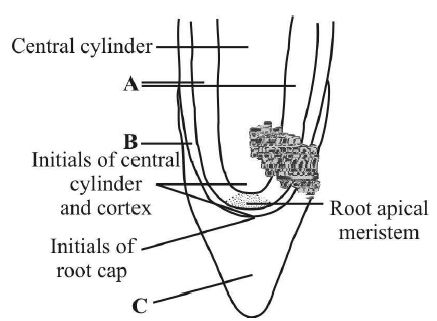
A. A Vascular structure, B Protoderm, C Root cap
B. A Cortex, B Endodermis, C Root cap
C. A Cortex, B Protoderm, C Root cap
D. A Tunica, B Protoderm, C Root cap
Answer : C

A. A Vascular structure, B Protoderm, C Root cap
B. A Cortex, B Endodermis, C Root cap
C. A Cortex, B Protoderm, C Root cap
D. A Tunica, B Protoderm, C Root cap
Answer : C
27. Gymnosperms are also called soft wood spermatophytes because they lack
A. cambium
B. phloem fibres
C. thick-walled tracheids
D. xylem fibres
Answer : D
A. cambium
B. phloem fibres
C. thick-walled tracheids
D. xylem fibres
Answer : D
28. Various functions like photosynthesis, storage, excretion performed by _____________.
A. sclerenchyma
B. parenchyma
C. collenchyma
D. aerenchyma
Answer : B
A. sclerenchyma
B. parenchyma
C. collenchyma
D. aerenchyma
Answer : B
29. Which one of the followings option shows the correct labelling of the parts marked as A, B, C and D in the given figure a lenticel?
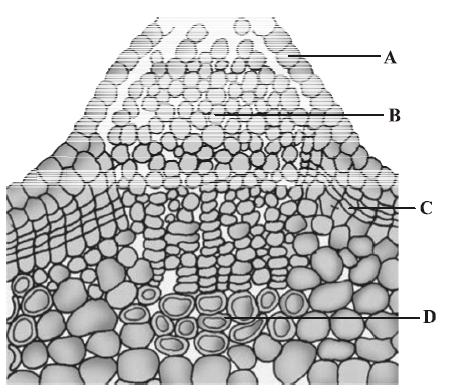
A. A Epidermis, B Secondary cortex, C Cork cambium, D Cork
B. A Pore, B Cork cambium, C Secondary cortex, D Cork
C. A Pore, B Cork, C Complimentary cells, D Cork cambium
D. A Epidermis, B Complimentary cells, C Cork cambium, D Secondary cortex
Answer : D

A. A Epidermis, B Secondary cortex, C Cork cambium, D Cork
B. A Pore, B Cork cambium, C Secondary cortex, D Cork
C. A Pore, B Cork, C Complimentary cells, D Cork cambium
D. A Epidermis, B Complimentary cells, C Cork cambium, D Secondary cortex
Answer : D
30. In an experiment, a student cut a transverse section of young stem of a plant which he has taken from his school garden.
After observing it under the microscope how would he ascertain whether it is a monocot stem or a dicot stem?
A. With the help of bulliform cells.
B. With the help of casparian strips.
C. With the help of vascular bundles.
D. With the help of stomatal apparatus.
Answer : C
After observing it under the microscope how would he ascertain whether it is a monocot stem or a dicot stem?
A. With the help of bulliform cells.
B. With the help of casparian strips.
C. With the help of vascular bundles.
D. With the help of stomatal apparatus.
Answer : C
31. Which of the following are present in monocot root ?
A. conjoint, collateral, open polyarch vascular bundle.
B. exodermis, endarch, tetrarch closed vascular bundles.
C. suberized exodermis, casparian strip, passage cells, cambium.
D. suberized exodermis, polyarch xylem, pith.
Answer : D
A. conjoint, collateral, open polyarch vascular bundle.
B. exodermis, endarch, tetrarch closed vascular bundles.
C. suberized exodermis, casparian strip, passage cells, cambium.
D. suberized exodermis, polyarch xylem, pith.
Answer : D
32. Xylem functions as a conducting tissue for water and minerals from _________to the ______and__________.
A. roots, stems, leaves
B. stems, roots, leaves
C. leaves, stems, roots
D. leaves, stems, leaves
Answer : A
A. roots, stems, leaves
B. stems, roots, leaves
C. leaves, stems, roots
D. leaves, stems, leaves
Answer : A
33. A vascular bundle in which the protoxylem is pointing to the periphery is called __________.
A. endarch
B. exarch
C. radial
D. closed
Answer : B
A. endarch
B. exarch
C. radial
D. closed
Answer : B
34. Lignin is the important constituent in the cell wall of
A. phloem
B. parenchyma
C. xylem
D. cambium
Answer : C
A. phloem
B. parenchyma
C. xylem
D. cambium
Answer : C
35. T.S. of monocot leaf is given below, certain parts have been marked by alphabets (A G). Which one is the option showing there correct labelling?
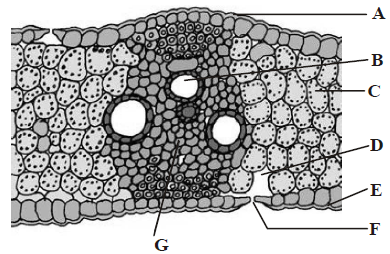
A. A Adaxial epidermis, B Xylem, C Mesophyll, D Sub-stomatal cavity, E Abaxial epidermis, F Stoma, G Phloem
B. A Adaxial epidermis, B Abaxial epidermis, C Xylem, D Sub-stomatal cavity, E Stoma, F Mesophyll, G Phloem
C. A Adaxial epidermis, B Phloem, C Mesophyll, D Sub-stomatal cavity, E Abaxial epidermis, F Xylem, G Stoma
D. A Adaxial epidermis, B Xylem, C Stoma, D Substomatal cavity, E Abaxial epidermis, F Phloem, G Mesophyll
Answer : A

A. A Adaxial epidermis, B Xylem, C Mesophyll, D Sub-stomatal cavity, E Abaxial epidermis, F Stoma, G Phloem
B. A Adaxial epidermis, B Abaxial epidermis, C Xylem, D Sub-stomatal cavity, E Stoma, F Mesophyll, G Phloem
C. A Adaxial epidermis, B Phloem, C Mesophyll, D Sub-stomatal cavity, E Abaxial epidermis, F Xylem, G Stoma
D. A Adaxial epidermis, B Xylem, C Stoma, D Substomatal cavity, E Abaxial epidermis, F Phloem, G Mesophyll
Answer : A
36. Which of the following process helps the trichomes in preventing water loss?
A. Where companion cells helps in maintaining the pressure gradient in the sieve tubes.
B. Where plants absorb water through the roots and then give off water vapor through pores in their leaves.
C. Where activity of cork cambium builds pressure on the remaining layers peripheral to phellogen and ultimately these layers dies and slough off.
D. None of the above
Answer : B
A. Where companion cells helps in maintaining the pressure gradient in the sieve tubes.
B. Where plants absorb water through the roots and then give off water vapor through pores in their leaves.
C. Where activity of cork cambium builds pressure on the remaining layers peripheral to phellogen and ultimately these layers dies and slough off.
D. None of the above
Answer : B
37. A common structural feature of vessel elements and sieve tube elements are
A. pores on lateral walls.
B. presence of p-protein.
C. enucleate condition.
D. thick secondary walls.
Answer : C
A. pores on lateral walls.
B. presence of p-protein.
C. enucleate condition.
D. thick secondary walls.
Answer : C
38. The trees growing in desert will
A. show alternate rings of xylem and sclerenchyma.
B. have only conjunctive tissue and phloem is formed by the activity of cambium.
C. show distinct annual rings.
D. not show distinct annual rings.
Answer : D
A. show alternate rings of xylem and sclerenchyma.
B. have only conjunctive tissue and phloem is formed by the activity of cambium.
C. show distinct annual rings.
D. not show distinct annual rings.
Answer : D
39. A student was given a tissue to observe under the microscope. He observes the tissue and concludes that the tissue is a type of simple plant tissue and provides mechanical support to young stem and petiole of leaf.
Identify the tissue.
A. Parenchyma
B. Collenchyma
C. Sclerenchyma
D. Xylem parenchyma
Answer : B
Identify the tissue.
A. Parenchyma
B. Collenchyma
C. Sclerenchyma
D. Xylem parenchyma
Answer : B
40. Match column-I with column-II and choose the correct option.
Which of the following combination is correct ?
A. A II, IV, VII, VIII; B I, III, V, VI
B. A I, II, VII, VIII; B III, IV, V, VI
C. A I, III, V, VI; B II, IV, VII, VIII
D. A I, III, VII, VIII; B II, IV, V, VI
Answer : C
| A. Spring wood or | I. Lighter in colour early wood |
|---|---|
| B. Autumn wood or | II. High density late wood |
| .. | III. Low density |
| .. | IV. Darker in colour |
| .. | V. Larger number of xylem elements |
| .. | VI. Vessels with wider cavity |
| .. | VII. Lesser number of xylem elements |
| .. | VIII. Vessels with small cavity |
Which of the following combination is correct ?
A. A II, IV, VII, VIII; B I, III, V, VI
B. A I, II, VII, VIII; B III, IV, V, VI
C. A I, III, V, VI; B II, IV, VII, VIII
D. A I, III, VII, VIII; B II, IV, V, VI
Answer : C
41. In the given columns, column I contain structures of female reproductive system and column II contain its feature. Select the correct match.
A. A - (i), B - (ii), C - (iii), D - (iv)
B. A - (iii), B - (i), C - (ii), D - (iv)
C. A - (i), B - (iv), C - (iii), D - (ii)
D. A - (ii), B - (iv), C - (iii), D - (i)
Answer : A
| Column-I | Column-II |
|---|---|
| A. Lateral meristem | (i) Fascicular vascular cambium, interfascicular cambium and cork cambium. |
| B. Apical meristem | (ii) Produces dermal tissue, ground tissues and vascular tissue. |
| C. Bast fibres | (iii) Generally absent in primary phloem but found in secondary phloem. |
| D. Sap wood | (iv) Involved in the conduction of water and minerals from the root to leaf. |
A. A - (i), B - (ii), C - (iii), D - (iv)
B. A - (iii), B - (i), C - (ii), D - (iv)
C. A - (i), B - (iv), C - (iii), D - (ii)
D. A - (ii), B - (iv), C - (iii), D - (i)
Answer : A
42. Identify types of vascular bundles in given figures A, B and C.
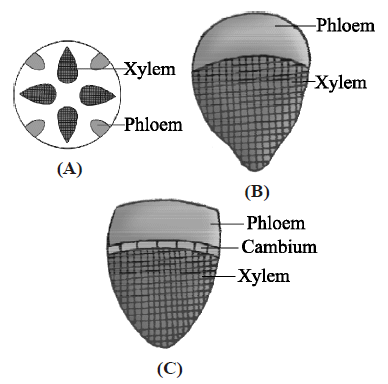
A. Radial; Conjoint closed; Conjoint open
B. Conjoint closed; Conjoint open; Radial
C. Conjoint open; Conjoint closed; Radial
D. Bicollateral; Concentric; Radial
Answer : A

A. Radial; Conjoint closed; Conjoint open
B. Conjoint closed; Conjoint open; Radial
C. Conjoint open; Conjoint closed; Radial
D. Bicollateral; Concentric; Radial
Answer : A
43. Phellogen and phellem respectively denote
A. cork and cork cambium,
B. cork cambium and cork,
C. secondary cortex and cork,
D. cork and secondary cortex,
Answer : B
A. cork and cork cambium,
B. cork cambium and cork,
C. secondary cortex and cork,
D. cork and secondary cortex,
Answer : B
44. In stems, the protoxylem lies towards the _____________ and the metaxylem lies towards the ____________ of the organ.
A. centre; periphery
B. periphery; centre
C. periphery; periphery
D. centre; centre
Answer : A
A. centre; periphery
B. periphery; centre
C. periphery; periphery
D. centre; centre
Answer : A
45. When we peel the skin of a potato tuber, we remove
A. periderm
B. epidermis
C. cuticle
D. leaves
Answer : A
A. periderm
B. epidermis
C. cuticle
D. leaves
Answer : A
46. Which of the following statements are correct ?
A. (i) and (iii)
B. (i) and (ii)
C. (iii) and (iv)
D. (i) and (iv)
Answer : B
- Xylem transports water and minerls.
- Gymnosperms lack sieve tubes and companion cells in phloem.
- The first formed primary xylem is called metaxylem.
- Phloem fibres (bast fibres) are made up of collenchymatous cells.
A. (i) and (iii)
B. (i) and (ii)
C. (iii) and (iv)
D. (i) and (iv)
Answer : B
47. The given figure shows T.S. of monocot stem. Identify the correct labelling of A to F marked in the given figure.
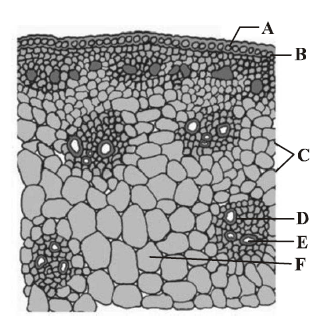
A. A Epidermis, B Hypodermis, C Vascular bundles, D Phloem, E Xylem, F Ground tissue
B. A Cuticle, B Epidermis, C Sclerenchymatous sheath, D Sclerenchymatous hypodermis, E Parenchymatous sheath, F Phloem
C. A Cuticle, B Epidermis, C Sclerenchymatous hypodermis, D Sclerenchymatous sheath, E Parenchymatous sheath, F Phloem
D. A Cuticle, B Epidermis, C Sclerenchymatous hypodermis, D Sclerenchymatous sheath, E Parenchymatous sheath, F Protoxylem
Answer : A

A. A Epidermis, B Hypodermis, C Vascular bundles, D Phloem, E Xylem, F Ground tissue
B. A Cuticle, B Epidermis, C Sclerenchymatous sheath, D Sclerenchymatous hypodermis, E Parenchymatous sheath, F Phloem
C. A Cuticle, B Epidermis, C Sclerenchymatous hypodermis, D Sclerenchymatous sheath, E Parenchymatous sheath, F Phloem
D. A Cuticle, B Epidermis, C Sclerenchymatous hypodermis, D Sclerenchymatous sheath, E Parenchymatous sheath, F Protoxylem
Answer : A
48. During the formation of leaves and elongation of stem, some cells left behind from the shoot apical meristem, constitute the
A. lateral meristem
B. axillary bud
C. cork cambium
D. fascicular cambium
Answer : B
A. lateral meristem
B. axillary bud
C. cork cambium
D. fascicular cambium
Answer : B
49. A plant tissue when stained showed the presence of hemicellulose and pectin in cells wall of its cells. The tissue is called
A. collenchyma
B. sclerenchyma
C. xylem
D. meristem
Answer : A
A. collenchyma
B. sclerenchyma
C. xylem
D. meristem
Answer : A
50. T.S. of dicot stem is given below, certain parts have been marked by alphabets (A I). Choose the option which shows their correct labelling.

A. A Epidermis, B Epidermal hair, C Parenchyma, D Starch sheath, E Hypodermis (collenchyma), F Vascular bundle, G Bundle cap, H Medulla or pith, I Medullary rays
B. A Epidermal hair, B Epidermis, C Hypodermis (collenchyma), D Parenchyma, E Endoderm is (Starch Sheath), F Pericycle, G Vascular bundle, H Medullary rays, I Medulla or pith
C. A Epidermal hair, B Epidermis, C Hypodermis (collenchyma), D Starch sheath, E Parenchyma, F Vascular bundle, G Bundle cap, H Medulla or pith, I Medullary rays
D. A Epidermal hair, B Epidermis, C Parenchyma, D Hypodermis (collenchyma), E Starch sheath, F Vascular bundle, G Bundle cap, H Medulla or pith, I Medullary rays
Answer : B

A. A Epidermis, B Epidermal hair, C Parenchyma, D Starch sheath, E Hypodermis (collenchyma), F Vascular bundle, G Bundle cap, H Medulla or pith, I Medullary rays
B. A Epidermal hair, B Epidermis, C Hypodermis (collenchyma), D Parenchyma, E Endoderm is (Starch Sheath), F Pericycle, G Vascular bundle, H Medullary rays, I Medulla or pith
C. A Epidermal hair, B Epidermis, C Hypodermis (collenchyma), D Starch sheath, E Parenchyma, F Vascular bundle, G Bundle cap, H Medulla or pith, I Medullary rays
D. A Epidermal hair, B Epidermis, C Parenchyma, D Hypodermis (collenchyma), E Starch sheath, F Vascular bundle, G Bundle cap, H Medulla or pith, I Medullary rays
Answer : B
Sharing is caring
Related Post
CAT - Heat & Mass Transfer 1000+ MCQ [Solved] PDF Download
FCI Recruitment - Software Engineering 1000+ MCQ [Solved] PDF Download
Multimedia and Graphics MCQ Solved Paper for NDA
IBPS RRB - Periodic Classification of Elements 1000+ MCQ [Solved] PDF Download
Refrigeration & Air-Conditioning 1000+ MCQ with answer for NDA
Selenium automation 1000+ MCQ with answer for SSC JE